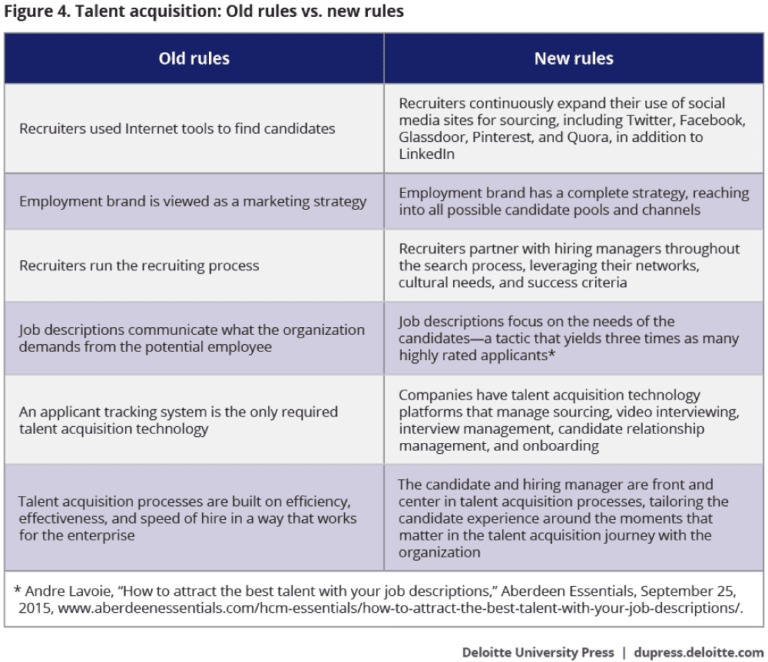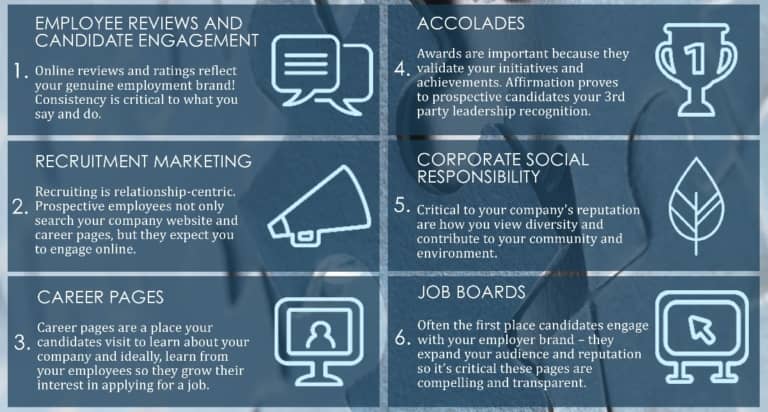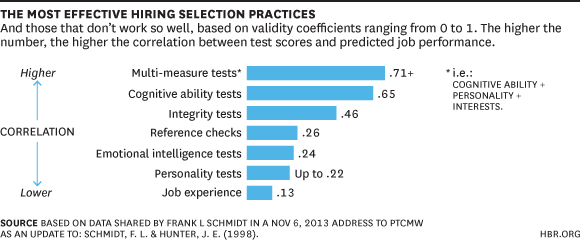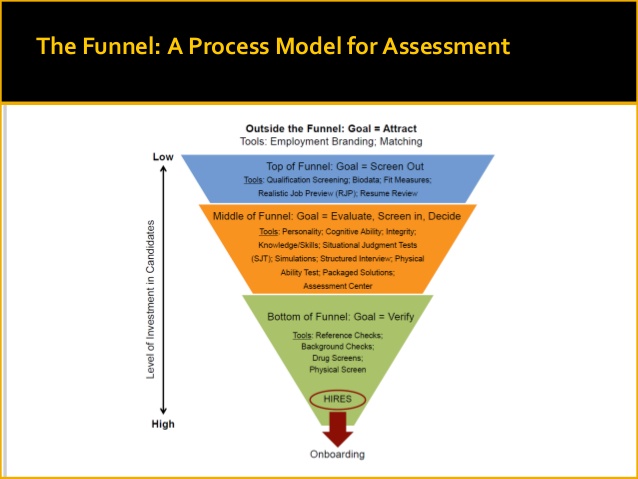Talent Acquisition
You will explore how to find and attract the talent that your innovation needs to be successful. Innovation is relatively easy with the right team. Innovation is impossible with the wrong team. You must build the right team, this guide intends to help you.
In this training, you will
- Explore approaches to talent acquisition.
- Consider branding to proactively attract talent, shifting from a talent seeker to a talent magnet.
- Use big data to improve the candidate experience.
- Learn how to navigate the initial candidate conversations.
- Ensuring you use a human touch to secure the candidates you want.
- Learn the costs and effects of bad hires.
Skills that will be explored
Job candidates are seeing opportunities everywhere and are running a race to find the best gig. If one employer takes too long to respond or the application is cumbersome, that candidate will sprint – digital device in hand – to the next job listing.
A Better Approach to Talent Acquisition
Take a moment to survey the talent landscape, because it has changed. Skills aren’t quite as easy to come by, and workers are switching employers to gain experience. According to a recent Gallup poll, 60 percent of the younger generation is open to new job opportunities, which implies that job hopping is a trend. Companies must attract the right talent now, and then hold onto it.
The figure below, from Deloitte, highlights the changes that have occurred in HRM and emphasizes how the rules have changed for talent acquisition. The employee’s needs and opinions are now the focus, not those of the employer.
The New Talent Acquisition Model

Source: Deloitte University Press, 2017
But before you decide to transform your talent acquisition processes, consider the impact of the changing landscape on your organizational ecosystem. Assess what infrastructure and talent you need now to meet the demands of better hiring for the future.
Develop a plan for incremental change in HR processes or a complete make-over if that’s what you need. If the latter is the case, it might be a good idea to bring in outside consultants who have experience with operations similar to your own to help determine the level of change your talent acquisition group needs and how to integrate other HR functions.
Finally, consider how functional your current HR systems are. Could you benefit from solutions that manage the basic, time-consuming tasks such as sourcing candidates? Is your HR ecosystem equipped to build emotional connections with candidates and strengthen your brand as an employer? This is what you should emphasize.
From Talent Seeker to Talent Magnet
Digital transformation has brought new rhetoric with myriad buzzwords: embedded talent acquisition, modular recruitment software, right sourcing, and data-driven recruitment are all good examples. But, refreshingly, the age-old recipe for talent acquisition will not steer you wrong: attract the right candidate at the right time, at the right price, with the right motivation.
The phrase “attracting” and not “finding” is key to transcending from a Talent Seeker to a Talent Magnet, which is required if the goal is to acquire competitive human capital for innovation. No less important are employment branding and developing candidate experience initiatives.
Employment Branding to Proactively Attract Talent
Applicants research companies as voraciously as companies research applicants. Employer branding is crucial so that potential candidates have a good impression of an employer from job sites such as Glassdoor.com and company websites. Your company website should be mobile-enabled, host a dynamic career page, and the content should be easy to read with minimal scrolling – even better, use micro videos.
Mobile users favor videos because a huge amount of information can be transmitted in two minutes. Companies should include subjects that might interest potential recruits and answer questions they might have about the company culture and mission. For example, include introductions to key projects, staff bios, or a tour of R&D or operational premises. These examples provided by Colin Hogan, contributor to Video Brewery, include videos from Starbucks, Shopify, and Dropbox.
“Ideas and solutions are centered around cognitive technologies such as artificial intelligence (AI), machine-to-machine learning, robotic process automation, natural language processing, predictive algorithms, and self-learning. Chatbots are becoming popular, including the recently launched Olivia, which guides candidates through an application process with sequenced questions.”
— Vartul Mittal, Global Business Transformation & Automation Leader, ATC Events & Media, 2016
How you look as an employer is down to your brand strategy. Potential applicants don’t hesitate to Google your reviews on job sites and even reach out on social media for feedback from current or old employees.
A side effect of the digital era with its penchant for social media platforms, employer review sites, and chat rooms is that companies are transparent to potential employees. This is great for employees but, depending on a company’s brand status, this can be either a benefit or a disadvantage to employers. Employment branding can amount to a PR campaign or disaster management, but it’s essential to build and preserve your reputation.
“We’re all aware of the advancing technologies and shifting corporate trends, and with this evolution brings more transparency making your company a glass house to candidates.”
– Wilson HCG, Digital Solutions company
The following six categories, developed by Wilson HCG, compose a great branding strategy. Address each one, then build a positive online presence for all categories.

Source: Wilson HCG, 2018
Highlight corporate social responsibility activities on your website along with the benefits of working for your organization. Post introductory micro-videos of your employees on your website and social media pages. It gives a personal touch and shows your workplace culture. Respond positively and assertively to any negative reviews that may appear on career pages.
It’s crucial to continuously manage your brand to mitigate any damage to your reputation. No matter how great your culture, there are always disgruntled employees. Any negative feedback should be dealt with promptly to minimize its impact and to show that the company is concerned with employees’ experiences. A negative posting on Facebook, for example, should address the poster’s concerns without being defensive.
For expert recruitment, many companies rely on their networks and word of mouth. That way, potential applicants come with a trusted recommendation. Developing a long-term partnership with a recruitment consultant means that a company’s needs are understood.
Good recruiters also maintain long-term relationships with their job search clients, even when they are gainfully employed. The best talent is typically not looking for a job, but a professional recruiter might be able to recognize a niche position and tempt the best person to consider a move.
Talent acquisition is a costly, ongoing endeavor. But in the same way that transforming a weather-beaten house into a fresh, modern, IoT-equipped dwelling is no easy feat, knowing the hidden costs up front, and fixing the underlying problems, will create a stronger structure. That stronger structure will be better able to attract and retain talent, because it is more modern, ready to respond to technology advancements, and prepped for the future.
How Big Data Tools Can Improve the Candidate Experience
There are two takeaways here: the need to prioritize the candidate experience and use big data and digital tools to streamline hiring.
The candidate experience is crucial, and it should be one that is convenient, fast, impressionable, and relationship-oriented. Employers need to maintain an open dialogue with candidates and provide them with information. Information is always a Google Search away, so keeping candidates informed of their application status keeps your company top of mind and satisfies the candidate’s thirst for feedback.
According to Siofra Pratt, contributor to Social talent, a company that does not have a mobile-enabled career site could miss 50 percent of potential candidates. Also, if applicants cannot apply using a mobile site, a company could lose up to 50 percent of applications they otherwise might have received if there had been a mobile application option.
These rapid, digital applications often do not require the submission of a resume. No longer the be-all and end-all of the application process, Wanda Thibodeaux, contributor to Inc. reports that companies such as Unilever are replacing resume digital scanning tools with internet and social media aggregation software. These solutions scan the internet and social platforms to determine the skills, background, social circles, and organizational involvements of applicants to determine their suitability. Resumes are becoming defunct.
Candidates also want an easy application process, confirmation that they are being considered or not – and they want answers to their questions quickly.
“Applicants to SAP receive an assessment report that tells them whether they are the right fit for the role. The candidate reaction is, ‘Wow! I’ve had instant feedback.’ Even with a rejection, it is better than sitting on a database hoping a recruiter will call in six months’ time.”
— Matthew Jeffery, VP and Head of Global Sourcing and Employer Branding at SAP, 2016
Cognitive recruiting is a hiring method that applies new technologies and solutions to build relationships. For example, Chatbots such as Olivia guide candidates through the application process. Gamification draws in applicants by prompting them to take tests or quizzes. The interaction makes the application process more enjoyable for the candidate and more productive for the employer who can analyze the results and compare them against a job skills profile.
Traditional applicant tracking systems are being replaced by data analytics that can identify passive candidates who, if approached, might be likely to consider an opportunity. Predictive analytics help to prioritize workflow, conduct pre-hire analyses, and assess the quality of hires.
Aggregation tools using big data and artificial intelligence could become the most popular screening method. For example, video interviews with the application of AI can identify promising candidates and replace traditional interviews, saving money and reducing time to hire.
As digital solutions take over much of the rote sourcing and sorting, HR professionals can concentrate on building psychological and emotional connections with applicants – something that software can’t yet do. These relationships are important for both parties to feel certain that the right candidate is being selected.
But here’s the bad news.
As the application process has become quicker and easier, the volume of applications has increased. According to a report by Michael Stephan, David Brown, Robin Erickson, human capital consultants for Deloitte, there has been an exponential increase in the volume of applications through sourcing channels, which has been detrimental to hiring effectiveness.
Candidates apply to roles that may not be exactly what they want because they can do so with just a few clicks or taps. Consequently, the recruiter is spending inordinate amounts of time sifting through applications. According to a survey by the Chartered Institute of Personnel and Development, close to 75 percent of employers surveyed said they had seen an increase in the number of applications from candidates who are not equipped to perform in the advertised role.
One way to combat applicant volume is to administer various tests to candidates during the hiring process, to increase the likelihood of a good hire. The graphic below is provided by the Harvard Business Review and is based on data from Frank L.Schmidt. The graph shows which tests are better predictors of future job performance.

Source: HBR , 2014
An algorithm scans those applications, 275,500 so far…The software weeds out more than half of the pool.”
— Joelle Hutcheon, Spokeswoman, Unilever
Here’s a guide to digital screening tools that can mitigate the problem of applicant volume and help identify the “best from the rest.”
Suitability Tools: Algorithm-based tools can take care of the first level of screening. They are optimized to assess candidate suitability based on requirements such as education, location, years of experience, and capabilities.
Elimination Tools: Elimination tools narrow down the pack by rejecting those least likely to be hired. Recruiters can then focus on the remaining candidates and factors such as cultural fit. Henri de Romrée, Bruce Fecheyr-Lippens, and Bill Schaninger, partners at McKinsey, claim that this step in the hiring process provides a 500 percent return on investment.
Commitment Hurdles: These are typically try-out activities, such as a skills test of some sort, included as a compulsory component in the application process. The tests determine the commitment and interest level of candidates early on, so that time and resources are not wasted in interviews.
“At Zulily, candidates for software engineering positions are given a take-home test to assess their ability to write code, merchandising candidates are required to pass a retail math test, demonstrating that they have a basic understanding of arithmetic … Analytics assessments are given to candidates vying for some jobs in marketing and operations.”
— Bill French, Head of Talent Acquisition, Zulily
It’s not uncommon for applicants to embellish their resumes, which can undermine screening tools and increase the work of the recruiter. John Bateson, Jochen Wirtz, Eugene Burke, and Carly Vaughan, contributors to The Harvard Business Review, state that a “test first” approach can eliminate 50 percent of applicants who are not up to the job, despite what they claim on paper. The authors note that companies in sectors such as retail or security can cut costs and save resources for the later, costlier interview process.
Competence tools that use artificial intelligence decide whether a candidate moves on to the next stage, and candidates who fail to perform well in the tests are automatically removed from the process.
“Unilever is using digital gamification for agile screening of graduate applications. Previously, recruiters screened six candidates to put one through the screening process; now recruiters are screening two candidates to put one through all four steps. ”
— Michael Stephan, David Brown, Robin Erickson, Human capital consultants Deloitte, 2017.
Each of the above technologies complements a stage in the hiring/recruitment funnel. The technologies are invaluable for whittling down the number of applications but, as the candidate pool shrinks, a human touch is required. The figure below, provided by Deloitte, shows the recruitment process from attracting candidates to onboarding.

Source: Deloitte, 2013
The Human Touch – Sealing the Deal
Shortlisting is where the first real “human” activity should occur. Recruiters and talent specialists need to physically view the machine-selected applications and make decisions on who to interview.
Losing a potential candidate at the offer stage is a blow but not uncommon. From the candidate’s perspective, if multiple offers are received, the employer that provided the best candidate experience and made the offer that most closely meets their needs will most likely be the lucky one.
The screening and interview experience should be easy and convenient to seal the deal. It pays to find out what motivates a selected candidate by asking the right questions during the interview and then offering them something as close as possible.
An employer of choice is one that offers a positive, unique, and exciting proposition that meets the needs of the candidate. An employer might be limited in terms of resources, but it might be able to offer mentorships or skills development that the employee is looking for but won’t find with another employer.
Unilever is a model case study for employee-centric IT talent acquisition. Rather than visit college campuses to recruit, the firm places targeted advertisements on Facebook and popular career sites like WayUp and the Muse. From there, interested candidates apply for entry-level jobs and internships in just a few clicks.
Unilever’s HR solutions pull information from the candidates’ LinkedIn profiles, an algorithm scans applications, weeding out over 50 percent, and humans take it from there.
Gamification, a strategy to engage applicants, is integrated into the entry-level recruitment process, and candidates are asked to play games to assess their concentration skills. Short-listed applicants submit videos of behavioral interviews on HireVue through a website or app. Artificial intelligence filters up to 80 percent of these candidates using data points such as how quickly they respond to questions, their facial expressions, and vocabulary. Depending on their responses, more candidates are weeded out according to their potential for success with the company.
The final step is the first time an algorithm is not involved – the in-person interview with HR managers and executives. The whole process is an easy and enjoyable one for the applicant. It is revolutionary, convenient, and effective.
Kelsey Gee, contributor to Fox Business, reports that hiring is faster and better for Unilever. Eighty percent of final-round candidates receive a job offer; the same percentage accepts. The company saves on recruiting costs although exact numbers have not been disclosed. How’s that for building a reputation and branding?
The Initial Candidate Conversation
An increasing number of first-round interviews are being conducted remotely and using communication platforms such as Skype, Google Hangouts, and FaceTime. Also, one-way interview videos are being submitted by applicants for later viewing by interviewers.
However, only a human can read between the lines of candidate responses. It’s important then, when developing interview questions, to think about the precise information you need to feel confident that the candidate is a good fit.
For example, does a candidate pause when asked why the job appeals to them? What do the facial expressions of the candidate reveal? Most communication is nonverbal, and only a human can interpret visual cues.
The CLAMPS (Challenge, Location, Advancement, Money, People, Security) model, provided by The Hill Group, a U.K.-based executive search company, can reveal the motivations behind a candidate’s application. The model considers how the candidate ranks certain work factors according to their motivational significance.
The debate lingers as to whether structured or unstructured interviews can better predict a candidate’s suitability. The structured interview is highly prescribed by behavioral specialists yet fiercely resisted by hiring managers, partly because the consensus is that building rapport with candidates is difficult through this type of interview. Identifying what the person can do in comparison to others can be achieved through structured questioning, but finding out who they really are is difficult.
Structured questioning might be a better choice for technical jobs where specific skills are crucial, while unstructured questions might give a creative person more of a chance to shine. However, unstructured interviews carry the risk that interviewer bias will affect decisions. It’s human nature for people to be drawn to those who remind them of themselves, which is an emotional reaction rather than a rational one and not conducive to creating a diverse and innovative workforce.
Again, rapport is important because the candidate is assessing the interviewers as much as they are assessing the candidate. The interview, ideally, should be an impressionable experience for the candidate. It is the main opportunity for the employer to lure the candidate in and convince them that they will be a good fit; it is also the prime opportunity for the candidate to feel assured that they will make the right decision if they receive an offer.
Incorporating both structured and unstructured techniques during the interview is an option. Following a scientific format coupled with scenario-based questions and social assessment techniques is a good balance, although each company is unique and should experiment with techniques and measure the results.
Job Profiling and Candidate Personality Traits
Social media and job sites mean that corporate interview questions are available – and predictable as a result. Candidates today can excel at interviewing if they do the legwork. They know that they should appear motivated and energetic, and they are asked the same routine questions in similar interview circumstances.
Therefore, job profiling should coincide with corresponding personality trait testing if constraints allow, which is harder for candidates to manipulate. By verifying a personality fit by testing against job requirements, the screening process becomes more targeted.
Suggested questions to identify personality traits are available with a simple Google search, and the adapted version of the Big Five Personality Traits Model comes highly recommended by talent experts, as do DiSC, Myers-Briggs, and StrengthsFinder.
“Candidates now routinely prepare and video their practice interviews to the point where their responses are universally impressive, if not genuine or accurate.”
— John Sullivan, HR Thought Leader, HBR
The strategies suggested in this article highlight the multitude of factors that go into the hiring experience. Firms won’t be able to implement every single method, so it’s important to stay flexible and find out what works for each unique situation. Keep an ear to the ground and borrow (steal) techniques from companies on the cutting edge of the hiring process.
The software platforms of pioneering companies have perfected candidate experience campaigns; Deloitte, Domino’s Pizza, Formaposte, General Electric, Goldman Sachs, Google, McDonald’s, Unilever, and Zappos are all case studies to explore. The approach of these companies reduces hidden recruitment costs by minimizing vacancy costs. Ongoing branding and outreach combined with gamification and easy job application ensure a stream of incoming talent.
As with any experience design, the process should be flexible and focused on long-term outcomes. Don’t run the 100-yard sprint to secure exceptional candidates – run the marathon of continuously bringing aboard top talent for innovation in your organization.
The Hidden Costs of Bad Hiring
It’s rarely the acquisition of an old house alone that creates financial hardship; more problematic are the trickle-down effects of existing problems that were never resolved. Leaky pipes, faulty wiring, drafty windows, and old appliances can all be devastating financially for the unsuspecting home owner. Building a strong basic structure free of underlying problems that can go undetected is also the responsibility of talent acquisition professionals. And, as with the acquisition of real estate, there are hidden costs to talent acquisition, which are almost never taken into consideration.
Innovation requires a strong workforce built with sensible methods such as effective marketing, targeted interviewing and, most importantly, a focus on the employee. But many companies make the mistake of hiring the wrong person, which is the number one hidden expense when it comes to talent acquisition and retention.
The hiring process includes interview expenses such as travel, hotel, and meals; training and orientation; and employment testing and screening. Then, if the wrong employee is hired and subsequently leaves, there are termination costs, such as temporary health care coverage or COBRA (Consolidated Omnibus Budget Reconciliation Act), and, in the worst case, potential litigation expenses.
If an unhappy employee stays, the costs can be even higher. According A.J. Agrawal, contributor to the Huffington Post, dissatisfied employees cost companies billions of dollars, sometimes sending them into bankruptcy. Decreased productivity, more careless accidents, and damage to brand reputation because of poor customer service are all symptoms of poor morale and worker discontent.
The real cost of open vacancies is another hidden cause of financial drain with a tremendous impact on profit. What’s more, it often eludes most organizational cost centers. The combined quantifiable cost of every unfilled position in the organization is no less impactful on the bottom line.
The DHI-DFH Mean Vacancy Duration measure which is provided by DHI Group, Inc. and Dr. Steven Davis, Professor of International Business and Economics at the University of Chicago, found the average job vacancy duration of professional and business services jobs to be 26.1 working days in 2016. In May, technology jobs remained open for 25.6 working days.
The figure below shows how to calculate the cost of vacant positions.

Source: G&A Partners
The Trickle-down Effects of Bad Hires
Beyond hidden costs, trickle-down effects of poor talent acquisition could be even more lethal to a business. High turnover can result in low morale, lost customers due to unsatisfactory service, lost sales, reduced product quality, and low production. Colleagues disrupted by turnover must shoulder the additional workload, and an environment where employees come and go is not a healthy one for innovation.
Drake International’s calculator will help you to determine the costs of “hiring wrong” for your organization. (Drake International, Video.) The calculation is based on benchmarking the cost of the employee (salary and benefits), the cost of other employees having to fill in while the position is vacant, the cost of filling the vacancy (hiring manager expenses, moving expenses, advertising and background check costs) onboarding costs, and productivity ramp-up.
Here is a summary of some of the trickle-down effects of having vacant positions, including those affecting management, team cohesiveness, and real costs, according to a white paper by the Ropella Group.
- Personnel costs: a six-month loss on an average manager’s contribution could cost $300K due to poor quality work because workers are stretched thin, there are increased errors, higher turnover, and less creativity.
- Teams suffer in terms of cohesiveness and time-to-productivity if a team leader position is lost.
- Real costs include delayed time to market, underused equipment, and decreased output.
- Management costs: there is a multiplier effect on productivity, recruitment, and worker frustration due to lack of support.
- Customer costs: there are fewer sales, customer attrition because of delayed products, and poor customer service.
- Competitive advantage costs: analysts consider the company weak, competitors consider the company vulnerable, and potential employees consider the company to be at risk of failure.




